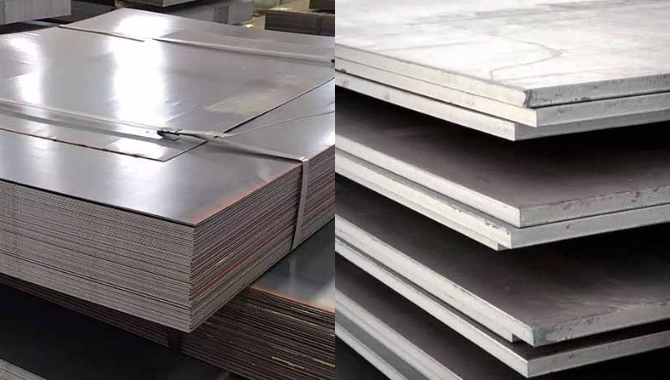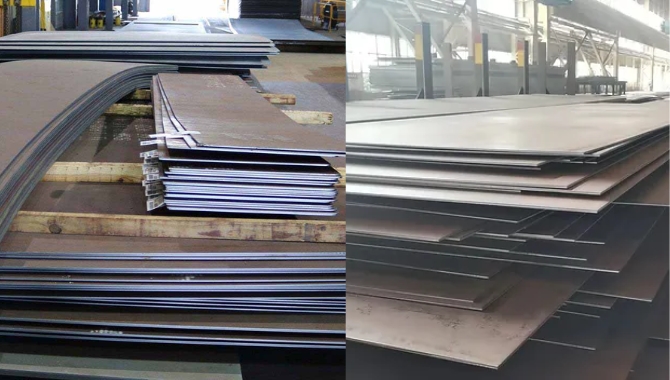When selecting structural steel, A36 and SA36 steels are two very common standards. But what sets them apart and why does selecting the right standard matter?
In this article, we’ll look at the properties, applications and cost considerations of both steels to deliver valuable insight for construction or industrial projects.
Fundamental Properties of A36 and SA36 Steel

It’s very important to understand characteristics of A36 and SA36 steel to make better choices for industrial and structural uses. These traits determine their appropriateness for certain applications and how the materials perform under different conditions.
Chemical Composition
| Element | ASTM A36 (%) | ASME SA36 (%) |
|---|---|---|
| Carbon | ≤ 0.26 | ≤ 0.26 |
| Copper | ≥ 0.20 | ≥ 0.20 |
| Sulfur | ≤ 0.05 | ≤ 0.05 |
| Silicon | 0.15 – 0.40 | 0.15 – 0.40 |
| Manganese | 0.80 – 1.20 | 0.80 – 1.20 |
| Phosphorus | ≤ 0.04 | ≤ 0.04 |
| Iron | Balance | Balance |
The chemical composition of A36 and SA36 is nearly identical, so many view them as interchangeable. But subtle differences in their certifications and standards can determine their use in some industries.
Mechanical Properties
The mechanical properties of A36 and SA36 steel are important to understand their uses in different operations. We’ll focus on main aspects:
Yield Strength
A36 and SA36 steel both have the yield strength of 36 ksi (250 MPa). This value shows the stress where plastic deformation starts. Structural engineers use this property to determine the highest load a part can handle without permanent deformation. For pressure vessels, yield strength is important in calculating operating pressures and wall thickness.
Tensile Strength
The tensile strength of A36 and SA36 steel goes from 58 to 80 ksi. This broad range permits manufacturing flexibility while guaranteeing structural integrity. Projects that need high-stress materials like for heavy machinery parts or bridge constructions, benefit from this strength.
Hardness
Both steels share identical hardness values that differ from 67-83 on Rockwell B scale and 119-159 on Brinell scale. This medium hardness supports outstanding machinability without compromising strength. Fabrication shops can easily drill and shape these steels and this make them perfect for complicated structural parts in buildings or bridges.
Modulus of Elasticity
A36 and SA36 steel have a modulus of elasticity of 200 GPa (29,000 ksi). This value shows their hardness and ability to resist deforming under load. In real terms, beams made from either steel grade will bend the same way when put under equal load. For example, A36 and SA36 steel columns in a skyscraper would give similar stability which assures structural integrity.
Key Differences between ASTM A36 and ASME SA36

Although A36 and SA36 steels are alike in many ways, they have a few important differences too. Let’s see how they vary in certification and following industry standards.
I. Certification and Compliance
The American Society for Testing and Materials (ASTM) certifies A36 steel and assures it meets particular needs for engineering and building uses. In contrast, SA36 steel is approved by the American Society of Mechanical Engineers (ASME). This society focuses on standards for boilers and pressure vessels.
A36 steel follows the A36/A36M standard. This sets its strength properties, testing methods and chemical structure. However, SA36 faces stricter requirements. It must meet the ASME Boiler and Pressure Vessel Code, Section II, Part A. This code requires extra testing and quality control to guarantee that SA36 is ready for high-pressure uses.
II. Cost Implications
The selection between A36 and SA36 steel can greatly affect your financial planning and project budget.
Material cost
SA36 steel usually costs more than A36 because of its extra certification necessities. Depending on market and supplier, this cost difference ranges from $50 to $200 per ton. The premium price shows the extensive testing and documents required for ASME certification. Despite this, the higher material cost may be counterbalanced in pressure vessel applications by possible insurance savings and decreased liability.
Lifecycle cost
For pressure vessel uses, SA36 usually proves more affordable. Its maximized quality control can decrease maintenance needs and lengthen service life. Over a usual 20-year life cycle, SA36 vessels may require one less major overhaul versus non-ASME certified alternatives. This difference can save tens of thousands of dollars in downtime and maintenance costs.
Applications of ASTM A36 Steel and ASME SA36 Steel
Both A36 and SA36 steels have roles in different industries. Here’s an overview of where you might see each steel type used.
Construction Industry
The construction industry heavily uses A36 for its great formability and weldability. High-rises mostly contain this steel in structural beams, plates and columns. Its 250 MPa yield strength makes it perfect for load-bearing elements. While SA36 steel also works for similar operations, it’s the best choice for structures with boiler systems like industrial facilities, thanks to its pressure vessel code compliance.
Bridge Engineering
Standard highway bridges usually use A36 because of its 400-550 MPa tensile strength which assures durability under heavy traffic loads. For bridges with built-in pressure systems like hydraulic lift bridges, engineers frequently use SA36 as it meets ASME boiler and pressure vessel codes.
Automotive Manufacturing
Automotive frame parts and chassis components regularly feature A36. Its 119-159 Brinell hardness allows easy fabrication of complex shapes. While less common here, SA36 might be found in customized vehicles with pressure-bearing parts like fire trucks with built-in water pumps.
Oil and Gas Industry
This industry shows a clear difference between the two steels. General structural parts in drilling rigs and refineries usually use A36. But SA36 steel is a better choice for storage tanks, pressure vessels and pipeline fittings. Its ASME certification and ability to withstand 400-550 MPa pressures make it very important for safety-critical uses here.
Shipbuilding
Both steels serve different purposes in shipbuilding. Structural supports and deck plates commonly use A36 and benefit from its 250 MPa yield strength.
The ASME certification of SA36 gives extra assurance and that’s why it is preferred for parts exposed to high-pressure environments like in submarine buildings or bulkheads near engine rooms.
Choosing Between A36 and SA36

Here are important points to consider when deciding between A36 and SA36 steels:
Application Requirements
Your project’s requirements should guide your steel choice. A36 normally works for general structural uses like building bridges or frames. Yet boilers or pressure vessels benefit more from SA36 steel because of its ASME certification.
Regulatory Compliance and Standards
Industry standards are integral for material selection. Projects that need to follow the ASME Boiler and Pressure Vessel Code require SA36 steel. For projects without such strict needs, A36 is usually more cost-effective and fulfills necessary standards.
Cost-Benefit Analysis
Look at both long and short terms expenses when picking between these steels. While A36 may have lower upfront costs, SA36 could give better value for uses needing frequent replacements or inspections. Assess aspects like material availability, possible maintenance costs and fabrication expenses to decide wisely.
Conclusion
Both A36 and SA36 steels have distinctive advantages that come from their particular attributes and certifications. Picking the right material requires careful consideration of these aspects.
For professional machining work with A36 or SA36 steel, get in touch with KDM Fabrication. Their experts will give you guidance on material choice and deliver custom fabricated parts that are customized to your project details.
Frequently Asked Questions:
What regulatory requirements must be met when using ASME SA36 in industrial projects?
ANS: Industrial projects using SA36 must adhere to some main regulatory requirements:
- Its use is required for projects that need ASME Boiler and Pressure Vessel Code approval, particularly in pressure vessels and boilers.
- The ASME Boiler and Pressure Vessel Code Section II governs its use.
- Firm quality control and tracking including material traceability, are required.
- Chemical composition tolerances are fixed.
- Following particular ASME-published design codes for pressure applications is important.
- Extra testing like ultrasonic testing is needed.
How do welding and machining processes differ when working with ASTM A36 compared to ASME SA36?
ANS: Welding and machining A36 and SA36 are mostly alike because of their similar mechanical attributes and chemical composition. Both steels weld easily using common methods like SMAW, FCAW, and GMAW.
The main difference is in quality control and documentation. SA36 steel requires firm traceability and testing for pressure vessel uses. So fabricating SA36 steel parts may need extra inspection steps.
Can ASTM A36 be used in place of ASME SA36 in certain construction projects, and what are the risks involved?
ANS: Most construction projects can use A36 instead of SA36.But this substitution isn’t allowed for applications that need ASME Boiler and Pressure Vessel Code compliance. The main risk comes from using A36 in pressure vessel applications where SA36 is particularly required.
For non-pressure vessel construction, A36 is usually a more cost-effective choice, but engineers must carefully think about project requirements before substituting A36 for SA36.




